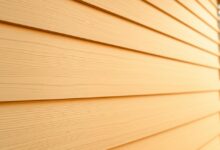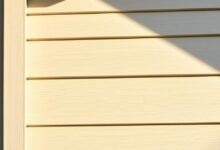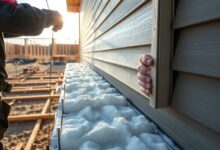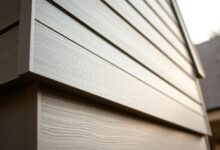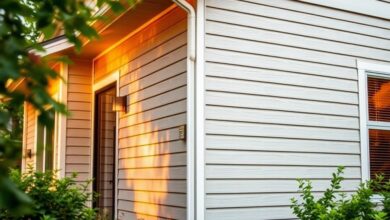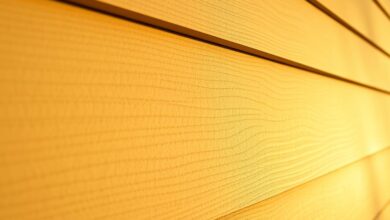Vinyl Insulated Siding: Durable, Energy-Efficient
Homeowners are always looking to make their homes better. They want them to be more energy-efficient and last longer. Vinyl insulated siding is a great choice because it offers many benefits.
This exterior siding makes a house look better and protects it from the weather. By picking the right siding, homeowners can save on energy costs. They can also make their property more valuable.
Key Takeaways
- Vinyl insulated siding offers durability and energy efficiency.
- It enhances the aesthetic appeal of a house.
- Reduces energy bills and increases property value.
- A robust barrier against the elements.
- A popular choice among homeowners.
Understanding Vinyl Insulated Siding
Vinyl insulated siding is a new way to cover your home’s exterior. It’s tough and helps save energy. Homeowners and builders love it for its special features and benefits.
The Structure and Components
This siding has two main parts: the outer vinyl layer and the insulating layer. The outer layer is strong PVC that doesn’t fade, crack, or get damaged by bad weather. The insulating layer, made from expanded polystyrene (EPS), keeps the inside warm and the outside cool.
This setup makes the siding not just strong but also energy-saving. The main parts are:
- Exterior vinyl layer for durability
- Insulating layer for thermal performance
- Interlocking system for secure installation
How It Differs from Standard Vinyl Siding
Vinyl insulated siding has an extra insulating layer. This makes it better at keeping your home warm in winter and cool in summer. It also makes your home quieter and more durable.
Here’s what sets it apart:
- Enhanced Energy Efficiency: It keeps your home’s temperature steady, saving energy.
- Increased Durability: The extra layer makes it stronger and less prone to damage.
- Better Noise Reduction: It blocks outside noise, making your home quieter.
Choosing vinyl insulated siding means a more comfy, energy-saving home. It’s also better for the environment.
Benefits of Vinyl Insulated Siding
Vinyl insulated siding has many benefits for homeowners. It improves your home’s performance and looks. This siding meets many home improvement needs.
Energy Efficiency and Cost Savings
Vinyl insulated siding boosts energy efficiency. It adds insulation, reducing heat loss in winter and cooling in summer. This saves a lot on energy bills.
Energy-efficient homes save money and are better for the planet. They use less energy and have lower utility bills. Vinyl insulated siding is a wise choice.
Durability and Weather Resistance
Vinyl insulated siding is very durable and weather-resistant. It handles extreme temperatures, heavy rain, and strong winds well. It’s perfect for homes in different climates.
The durable construction of vinyl insulated siding keeps it looking good for years. It means less need for repairs or replacements.
Noise Reduction Properties
Vinyl insulated siding also reduces noise. Its extra insulation blocks outside sounds. This makes your home quieter and more peaceful.
Homeowners get a quieter home, away from outside noise. Vinyl insulated siding is great for busy or noisy areas.
Aesthetic Options and Curb Appeal
Vinyl insulated siding comes in many colors and styles. Homeowners can pick the best look for their home. This makes it easy to improve curb appeal and your home’s look.
With vinyl insulated siding, your home’s exterior will be beautiful and inviting. It looks great and offers long-term performance and value.
Installing Vinyl Insulated Siding: Step-by-Step Guide
To get the best results with vinyl insulated siding, following a step-by-step guide is key. This makes the installation smooth and effective. It also ensures your home is energy-efficient and durable.
Pre-Installation Planning
Planning is essential before you start. You need to measure your home and pick the right materials.
Measuring Your Home
Getting accurate measurements is critical. This helps you buy the right amount of siding. Measure each wall’s height and width, remembering to include windows and doors.
Choosing the Right Materials
Choosing the right vinyl insulated siding is important. Consider your home’s climate, style, and budget. Make sure the siding fits your home’s structure.
Tools and Materials Checklist
Having the right tools and materials is key for a successful installation. Here’s a checklist to help you prepare:
| Tools | Materials |
|---|---|
| Tape measure | Vinyl insulated siding panels |
| Utility knife | Insulation backing |
| Drill | Nails or siding nails |
| Level | J-channel |
| Pencil | Corner posts |
Installation Process
The installation process has several key steps. It starts with removing old siding and ends with finishing touches.
Removing Old Siding
Remove the old siding carefully to avoid damage. This may involve removing nails and gently prying off the old siding.
Installing Insulation Backing
Install the insulation backing as the manufacturer’s instructions say. This step is key for better energy efficiency.
Start attaching the vinyl siding panels from the bottom up. Make sure they are level and securely fastened. Follow the manufacturer’s guidelines for overlapping the panels.
Finishing Touches
Finish the installation by adding finishing elements like J-channel around windows and doors, and corner posts. Make sure all edges are sealed properly.
Maintaining Your Vinyl Insulated Siding
To keep your vinyl insulated siding working well, regular care is important. It helps it stay energy-efficient and durable. This care also makes it last longer, saving you money.
Seasonal Cleaning Guide
Cleaning your siding every season is a must. It gets rid of dirt, grime, and mildew. These can harm its look and how well it works. Use a soft brush or a low-pressure washer with a wide fan tip.
Avoid strong washes or harsh cleaners. They can harm the siding.
For tough stains, mix water with mild detergent. Use a soft brush to apply it, starting from the bottom. This stops dirt from running down. Then, rinse well with clean water.
Addressing Common Issues and Repairs
Even though it’s tough, vinyl siding can get damaged. You might see cracks, dents, or loose panels. Check your siding often to catch problems early.
For small damages, you can fix them yourself. For example, replace a damaged panel by taking out the old one and putting in a new one. Make sure it’s fastened right, following the maker’s guide.
When to Call a Professional
Some jobs are better left to the pros. If you see big damage like large cracks or warping, get help. Also, if you’re not sure about a repair or it’s complex, experts can help. They ensure the job is done right and avoid more damage.
Enhancing Your Home with Vinyl Insulated Siding
Vinyl insulated siding is a great choice for homeowners. It boosts your home’s energy efficiency, durability, and looks. Knowing how it works and how to install it helps you make a smart choice for your home’s exterior.
This siding saves energy and cuts down on costs over time. It’s built to last, handling different weather conditions well. This means your home’s exterior stays strong and looks good for years with little upkeep.
Choosing vinyl insulated siding is a smart move for homeowners in the U.S. It makes your home look better, reduces outside noise, and makes your living space more comfortable.
